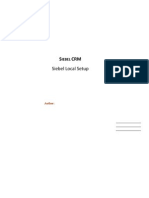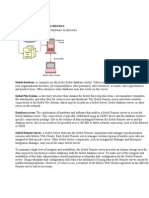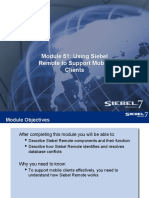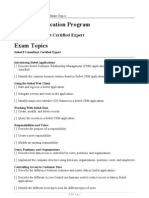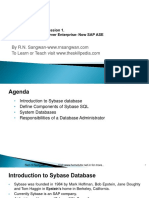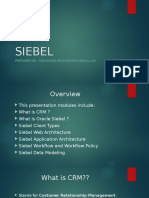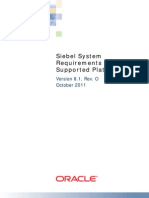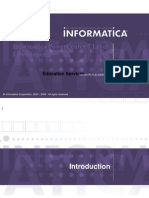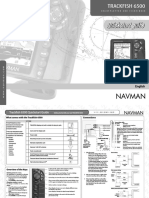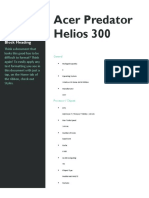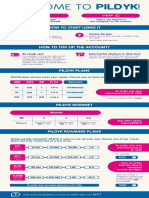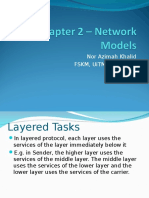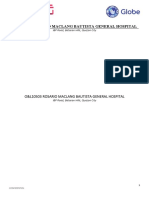21ESS TheConfigurationProcess
Uploaded by
laxmisingh03321ESS TheConfigurationProcess
Uploaded by
laxmisingh033The Configuration Process 21.
Time: Lecture: 15 - 20 minutes; labs: 65 – 95 minutes
Siebel 8.0 Essentials
Intent: To explain the basic principles for configuring a Siebel
application. This is the first of several modules in the Configuration
section of the course that explains how to change the standard (as-
delivered) application.
Flow: setting up the development environment; and creating individual
developers (configurators) who would make the changes to the
Module 21: The Configuration application.
Process Key Terms:
Development Environment
Local Repository
Siebel Remote
Generate DB
Extract DB
Initialize DB
Copyright © 2007, Oracle. All rights reserved. Populate DB
sse_data.dbf
User Login
Local Database Template
ODBC
Siebel 8.0 Essentials
The Configuration Process 21.2
Each objective and “why you need to know” should be stated aloud.
Module Objectives
n After completing this module you should be able to:
} Describe the development environment architecture
} Set up the development environment
n Why you need to know:
} Being able to set up the development environment is critical to
carrying out a successful configuration
Copyright © 2007, Oracle. All rights reserved. 2 of 20
Siebel 8.0 Essentials
The Configuration Process 21.3
Siebel Remote uses a local database to store changes made via the
The Development Environment remote device, and that database is periodically updated with the server
database. Siebel uses the same method to implement a development
n Siebel Remote is used to establish a local development environment. The developer’s work is saved to a local database where
environment
changes are isolated from the server, then periodically updated with the
n Siebel Developer Web Client provides full Siebel application server database in a controlled manner. This provides the developer an
functionality in a local environment environment where the part of the database being developed can be
} Accesses a local DB containing a subset of the server database manipulated off-line from the larger development community.
} Synchronizes with the server database, as necessary Note: synchronization in the development environment can be performed
} Implements a development and testing environment for individual on an “as needed” basis. For example, if the developer starts a new
developers
project working in an area she previously did not have access, SADMIN
Enterprise must provide view access to the new areas. The developer can then
Local
Server
Siebel Server Developer Web Client CFG
synchronize with the server to gain access, as necessary.
CFG
Synchronization Manager Object Manager Local
Server
SRF
SRF
Server Siebel File Local Local
Database System Database SFS
Copyright © 2007, Oracle. All rights reserved. 3 of 20
Reference Using Siebel Tools
Siebel Remote and Replication Manager Administration
Guide
Developing and Deploying Siebel Business Applications:
Setting Up a Developer’s Local Database
Siebel 8.0 Essentials
The Configuration Process 21.4
0/8
This is a structuring slide. Do not teach the steps or concepts here
Procedure for Setting Up the Development Environment because the following slides cover them in detail. Provide a high-level
description of what will be discussed.
1. Enable the Development Environment
2. Create the Developer
3. Create a User Login
4. Generate the Local Database Template
5. Extract User Data
6. Modify and Verify Configuration Settings
7. Initialize Local Database
8. Extract Repository Data
Copyright © 2007, Oracle. All rights reserved. 4 of 20
Siebel 8.0 Essentials
The Configuration Process 21.5
1/8
There are several simple administrative steps that must be taken to
Enable the Development Environment enable the development environment.The first is synchronize then to
enable Siebel Remote.
n Enable the Siebel Remote component group to enable
development using a local database One of the changes for 8.0 is that the Enable on Server option must be
} After enabling a component group, do not forget to restart the
checked.
Siebel Server and synchronize components
Enable Siebel
Remote
Copyright © 2007, Oracle. All rights reserved. 5 of 20
Siebel 8.0 Essentials
The Configuration Process 21.6
2/8
Students have already created employees when they set up the company
Create the Developer structure in the Security section. The only new thing here is the mobile
client. PPENGUIN is the login used for the developer user in the course.
n Add the developer as an employee The developer user is created as a mobile client because they need to use
n Associate a position and responsibility a local database.
n Register the developer as a mobile client In the lab, students create a new ABC Developer responsibility with
repository views. The responsibility provides a way to control access by
Add employee
record
assigning a set of views associated with a job role. In general, you
probably want to limit the views a developer can access. You can control
access for developers by creating a new responsibility that contains only
those views required by the developer and then associating it to the
developer’s user record.
Since the developer environment uses Siebel remote, each developer
must be setup as a remote client. One value you’ll set is Routing Models,
which are used to reduce the amount of data replicated to mobile users.
Reducing data replication can reduce synchronization and transaction
Register mobile times for some users. For a majority of mobile users, the MOBILE
client
CLIENT - STANDARD, MOBILE CLIENT - EXTRACT ONLY, or
Copyright © 2007, Oracle. All rights reserved. 6 of 20
Executive Management routing model is adequate. Before you deploy
Siebel Remote with any of the other specialized routing models, it is
strongly recommended that you discuss this with a Siebel technical
resource.
Siebel 8.0 Essentials
The Configuration Process 21.7
3/8
There must be a corresponding database account for the user. This is an
Create a User Login activity typically performed by a database administrator.
n If necessary, create a corresponding database login using The grantuser.sql script, which resides in
RDBMS tools and the grantusr.sql script as a template C:\SUsea\dbsrvr\ <database server type>,
contains the syntax for creating a database user in the respective
n Example:
RDBMS.
The screenshot includes a sample from the grantusr.sql script. The
format of the commands are specific to the server database. This sample
shows MS SQL Server syntax (the RDBMS used in the labs).
Screen shot from Microsoft SQL Server Management Studio Express copyright • Microsoft Corporation
Copyright © 2007, Oracle. All rights reserved. 7 of 20
Siebel 8.0 Essentials
The Configuration Process 21.8
4/8
The Generate New Database server task creates a series of files that
Generate the Local Database Template capture the current database’s structure (schema), at that point in time.
Therefore, the developer user has a representation of the same tables and
n Run the Generate New Database server task to generate a local columns contained in the server database on their local database. Note
database template
that the output of this server task is placed under a directory called
} Snapshot of the current version of the database schema (tables, DBTEMPL on the server machine.
columns, indexes, and so forth)
Students have seen how to run server tasks in prior modules. This is the
first real application. Notice that the template is specific to a given
version of the database schema.
If columns are added, a new template needs to be created. The template
here is for SQL Anywhere, but one can also be generated for MS SQL
Server. This would be defined in the Client Db Type parameter in the
Generate New Database task. The task is discussed in more detail in the
modules on Siebel Remote.
Copyright © 2007, Oracle. All rights reserved. 8 of 20
Siebel 8.0 Essentials
The Configuration Process 21.9
5/8
Database Extract retrieves from the server database the user visible data
Extract User Data for a specific mobile client, and packages the data into compressed files.
When you initialize the database, this data is then used to populate the
n Run the Database Extract server task to extract user data local database with user data (not repository data). Database Extract uses
} Generates compressed data files the schema represented in files from the Generate New Database task,
n Stored on the server which should be run immediately before extracting user data.
} User data is extracted for the user(s) specified in the job
parameters Ensure you enter the full name for the mobile client, such as
PPENGUIN. When using Client Name during database extract, Siebel
Remote searches for the “node” name, which is identified by the full
mobile client name. If you fail to enter the full name, as specified in
Siebel Remote > Mobile Clients, you will receive an “Unable to find
node in database” error.
Data is extracted to the specified
mobile user’s directory
Copyright © 2007, Oracle. All rights reserved. 9 of 20
Siebel 8.0 Essentials
The Configuration Process 21.10
6/8
When you initialize the local database you create a database called
Modify Configuration Settings sse_data.dbf on the developer’s local machine, and then populate it with
data visible to the user. Because you want to perform configuration tasks
n Modify configuration information for Siebel Tools in using this database, you need the repository data. This data does not
..\tools\BIN\<Language Code>\tools.cfg
come from Database Extract. Database Extract is done for all mobile
} For example, ..\tools\BIN\ENU\tools.cfg users, but repository information is specific to developers. Therefore,
n Modify configuration information for Siebel Developer Web developers use Siebel Tools to connect to the server using ODBC, and
Client in ..\client\BIN\<Language Code>\<application>.cfg copy the repository data into the local database.
} For example, ..\client\BIN\ENU\uagent.cfg for the Siebel Call You need to verify/update the ODBC data source for Tools, connecting
Center Developer Web client
to the server. The Siebel Server installation program automatically
n Both configuration files hold critical information to ensure proper creates an ODBC system data source name (DSN) that it uses to connect
behavior of local executables: to the Siebel Database Server.
} Native client connection information for the local database
This setting ensures ODBC is directed to the database you are about to
} ODBC connection for the server
initialize. In the lab, you will create an ABC application on Penguin’s
} ODBC connection for the local database local machine. If this setting is configured incorrectly, ODBC will not be
} Location of the local Siebel file system able to locate the database, and you will receive an invalid user/password
error any time you attempt to access the ABC application.
Copyright © 2007, Oracle. All rights reserved. 10 of 20
Siebel 8.0 Essentials
The Configuration Process 21.11
6/8
When you initialize the local database you create a database called
Example Configuration Settings sse_data.dbf on the developer’s local machine, and then populate it with
data visible to the user. Because you want to perform configuration tasks
n Example: tools.cfg (edited for length) using this database, you need the repository data. This data does not
come from Database Extract. Database Extract is done for all mobile
Overall configuration: Name of
SRF file, application name, root
users, but repository information is specific to developers. Therefore,
directory, and ODBC connections developers use Siebel Tools to connect to the server using ODBC, and
to local and server databases for copy the repository data into the local database.
testing connectivity
You need to verify/update the ODBC data source for Tools, connecting
Available data sources. Add more if needed. to the server. The Siebel Server installation program automatically
creates an ODBC system data source name (DSN) that it uses to connect
to the Siebel Database Server.
This setting ensures ODBC is directed to the database you are about to
Local connection information,
initialize. In the lab, you will create an ABC application on Penguin’s
including native connect string. Note local machine. If this setting is configured incorrectly, ODBC will not be
absolute path. Modify if local able to locate the database, and you will receive an invalid user/password
database is in a different location.
Server connection error any time you attempt to access the ABC application.
information
Copyright © 2007, Oracle. All rights reserved. 11 of 20
Siebel 8.0 Essentials
The Configuration Process 21.12
6/8
When you initialize the local database you create a database called
Verify Web Client ODBC Connections sse_data.dbf on the developer’s local machine, and then populate it with
data visible to the user. Because you want to perform configuration tasks
n Ensure that the Web Client ODBC connection references the using this database, you need the repository data. This data does not
local database
come from Database Extract. Database Extract is done for all mobile
} The database file parameter of SEAW Local Db default instance users, but repository information is specific to developers. Therefore,
must match ConnectString in [Local] section of uagent.cfg
developers use Siebel Tools to connect to the server using ODBC, and
} ConnectString must point to local DB: \client\LOCAL\sse_data.dbf copy the repository data into the local database.
Web Client
You need to verify/update the ODBC data source for Tools, connecting
connection. . . to the server. The Siebel Server installation program automatically
creates an ODBC system data source name (DSN) that it uses to connect
to the Siebel Database Server.
This setting ensures ODBC is directed to the database you are about to
initialize. In the lab, you will create an ABC application on Penguin’s
. . .must local machine. If this setting is configured incorrectly, ODBC will not be
match
able to locate the database, and you will receive an invalid user/password
error any time you attempt to access the ABC application.
Must point to local DB
Copyright © 2007, Oracle. All rights reserved. 12 of 20
Siebel 8.0 Essentials
The Configuration Process 21.13
6/8
In addition to the web client, Siebel Tools also uses ODBC as its
Verify Tools ODBC Connections connection method to sse_data.dbf. In ODBC Data Source
Administrator, the Tools connection appears as SSD Local Db default
n Ensure that the Tools ODBC connection references the local DB instance.
} The database file parameter of SSD Local Db default instance
must match ConnectString in [Local] section of tools.cfg You need to verify that Tools is correctly configured to connect to the
server and local databases. When logging into the local database you
connect directly to the connect string specified in the [Local] section of
the .cfg file. When you are logged into a local database, the Mobile Web
Tools Client is allowed to synchronize. This synchronization takes place on the
connection
... Siebel Server designated in the .cfg file.
The connect string specified in Tools.cfg can be verified by viewing the
Technical Support dialog in the Tools application.
As illustrated in the slide, the database file to which the Adaptive Server
Anywhere executable is directed must match Tools’ connect string.
. . .must
match
Copyright © 2007, Oracle. All rights reserved. 13 of 20
Siebel 8.0 Essentials
The Configuration Process 21.14
6/8
To ensure the ODBC connection, you can use the Test Data Source
Test Tools ODBC Login option that appears at the end of a series of configuration screens in
ODBC Data Source Administrator. The test will establish a connection,
n Check user IDs and passwords, and then test the connection verify option settings, then disconnect from the server.
1. Check
2. Test
Copyright © 2007, Oracle. All rights reserved. 14 of 20
Siebel 8.0 Essentials
The Configuration Process 21.15
7/8
You can initialize the database by launching tools or the web client.
Initialize Local Database Either way, the Siebel Remote Parameters dialog will display. Database
initialization creates a database by the name of sse_data.dbf, and then
n Local database is initialized upon first login to client populates it with the data visible to the user. The local client connects to
} Creates local database (sse_data.dbf) from template the Siebel Server to pull down the database schema and data files to
} Populates local database with data from compressed files create a new local database. Again, this is covered in detail later in the
Siebel Remote modules.
In the lab, you will initialize the sse_data.dbf SQL Anywhere local
database using Siebel Remote. In this step, you’ll use an Upgrade
Wizard to perform the initialization. During database schema upgrades,
new and changed objects are identified by comparing the current
physical schema with the new virtual schema. Based on this comparison,
Upgrade Wizard adds new objects and alters existing objects. Upgrade
Wizard first applies the new local database (including a new schema) to
Local db
the remote user's machine. Next, Upgrade Wizard applies any server
transactions downloaded during synchronization.
Possible Demo: in the lab, you will perform an important verification
step. If the configuration is incorrect, Tools may still open but be
Copyright © 2007, Oracle. All rights reserved. 15 of 20
mapped to a database other than the local sse_data.dbf database. You
must be able to log in as PPENGUIN connected to the local sse_data.dbf
database in order to continue with the labs.
Siebel 8.0 Essentials
The Configuration Process 21.16
8/8
Next, you Ppopulate the local database with object definitions from the
Extract Repository Data repository. Since you want to perform configuration tasks using this
database, you need the repository data. This data does not come from
n Perform a Get to extract repository data Database Extract, which is performed for all mobile users. Developers
} Copies all objects from the server repository to the local repository require repository information that is specific to development tasks.
} Must be performed before compiling Developers use Siebel Tools to connect to the server using ODBC and
n SRF must be based on the full set of Siebel objects copy the repository data into the local database.
“Get” all projects to
extract repository
data
Copyright © 2007, Oracle. All rights reserved. 16 of 20
Siebel 8.0 Essentials
The Configuration Process 21.17
This slide brings together the previous several slides into a single image
The Big Picture that illustrates the four steps required to create a usable local database.
n Steps to create a usable local database This slide illustrates:
1. The template and compressed files are generated on the server first.
Server
2. The Extract task extracts user data. User data is extracted from
Template 3. Use templates siebeldb.mdf.
provides to initialize local
schema DB and populate 3. Repository data is extracted from the server database by peforming a
user data
full Get.
1. Generate DB template Client 4. The local database is created and populated with user and repository
Compressed
data using the template files and compressed user and repository data
files provide files stored on the server.
user data Local
Database
2. Extract
user data
Server
Server database Database
provides
Repository
repository data 4. Extract
Data
repository data
Copyright © 2007, Oracle. All rights reserved. 17 of 20
Siebel 8.0 Essentials
The Configuration Process 21.18
This slide summarizes the work that must be done for each additional
Additional Developers developer.
n For each additional developer: Each developer should have his or her own machine, and needs to
1. Create the developer
undergo the same process steps described. The result is each developer
has their own local databases and an exact copy of all the definitions that
2. Create a user login
reside in the server repository.
3. Extract the local database
4. Initialize the local database
5. Verify login and data sources
Server Machine Developer Developer Developer
Workstation Workstation Workstation
Server Local Local Local
Copyright © 2007, Oracle. All rights reserved. 18 of 20
Siebel 8.0 Essentials
The Configuration Process 21.19
Review Question: When would developers working on a Siebel
Module Highlights configuration modify the code in siebel.exe?
n Siebel Remote is used to establish a local development Answer: They wouldn’t.
environment Review Question: Why should you set up a separate development
n An individual developer uses Siebel Developer Web Client to environment for configuration?
develop and test custom configurations Answer: To isolate the development effort from the enterprise’s
n Create the development environment by: production database. Also acceptable: To allow developers to work
} Installing Siebel Tools on the client independently on different aspects of the development effort; to test
} Enabling Siebel Remote on the server customizations and extensions thoroughly prior to deployment.
} Creating a developer, login, and remote user on the server
} Generating, extracting, and initializing a local database
} Verifying login and data sources
Copyright © 2007, Oracle. All rights reserved. 19 of 20
Siebel 8.0 Essentials
The Configuration Process 21.20
Lab
n In the lab you will:
} Set up an employee as a developer
} Extract a local database for the developer
} Populate the developer’s local database with user and repository
data
Copyright © 2007, Oracle. All rights reserved. 20 of 20
Siebel 8.0 Essentials
You might also like
- Developing and Deploying Siebel Business Applications: Version 8.1, Rev A December 2010No ratings yetDeveloping and Deploying Siebel Business Applications: Version 8.1, Rev A December 2010212 pages
- 51ESS - Using Siebel Remote To Support Mobile ClientsNo ratings yet51ESS - Using Siebel Remote To Support Mobile Clients33 pages
- Module I: Siebel 8.0 Essentials TrainingNo ratings yetModule I: Siebel 8.0 Essentials Training17 pages
- Implementing Siebel Ebusiness ApplicationsNo ratings yetImplementing Siebel Ebusiness Applications238 pages
- TECHNICAL NOTE 0140: Managing The Siebel Development EnvironmentNo ratings yetTECHNICAL NOTE 0140: Managing The Siebel Development Environment19 pages
- Siebel 8 Consultant Certified Expert CertificationNo ratings yetSiebel 8 Consultant Certified Expert Certification7 pages
- Siebel System Requirements and Supported Platforms Version 8.1 (SRSP - 81)No ratings yetSiebel System Requirements and Supported Platforms Version 8.1 (SRSP - 81)120 pages
- Siebel Portal Framework Guide: November 2008No ratings yetSiebel Portal Framework Guide: November 2008126 pages
- 2.1.2. Students 2.1.3.2. Faculty 2.2 University 2.4. Human Resource Management Office 3. ManagementNo ratings yet2.1.2. Students 2.1.3.2. Faculty 2.2 University 2.4. Human Resource Management Office 3. Management10 pages
- Siebel Anywhere Administration Guide: March 2008No ratings yetSiebel Anywhere Administration Guide: March 2008154 pages
- Step 1 Oracle 11g Enterprise Server InstallationNo ratings yetStep 1 Oracle 11g Enterprise Server Installation24 pages
- Using Siebel Tools: Version 8.0, Rev. A August 2007No ratings yetUsing Siebel Tools: Version 8.0, Rev. A August 2007244 pages
- Adaptive Server Anywhere Database Administration Guide: Part Number: 38123-01-0900-01No ratings yetAdaptive Server Anywhere Database Administration Guide: Part Number: 38123-01-0900-01753 pages
- Siebel: Prepared By: Mohamad Ridzuan Bin AbdullahNo ratings yetSiebel: Prepared By: Mohamad Ridzuan Bin Abdullah23 pages
- Siebel System Requirements and Supported Platforms: Version 8.1, Rev. O October 2011No ratings yetSiebel System Requirements and Supported Platforms: Version 8.1, Rev. O October 2011115 pages
- 1-The Database Environment and Development ProcessNo ratings yet1-The Database Environment and Development Process30 pages
- Informatica Powercenter 7.1 Basics: Education ServicesNo ratings yetInformatica Powercenter 7.1 Basics: Education Services287 pages
- Siebel Reports Guide: Version 8.1, Rev. C June 2010No ratings yetSiebel Reports Guide: Version 8.1, Rev. C June 2010160 pages
- Packet Tracer - Access Control List Demonstration: ObjectivesNo ratings yetPacket Tracer - Access Control List Demonstration: Objectives3 pages
- Openscape Business v2 Feature Description Issue 7No ratings yetOpenscape Business v2 Feature Description Issue 7676 pages
- Data Analysis With STATA - Sample ChapterNo ratings yetData Analysis With STATA - Sample Chapter22 pages
- Gowifi - Ahd - HLD - Rosario Maclang Bautista General Hospital Rev1No ratings yetGowifi - Ahd - HLD - Rosario Maclang Bautista General Hospital Rev132 pages


